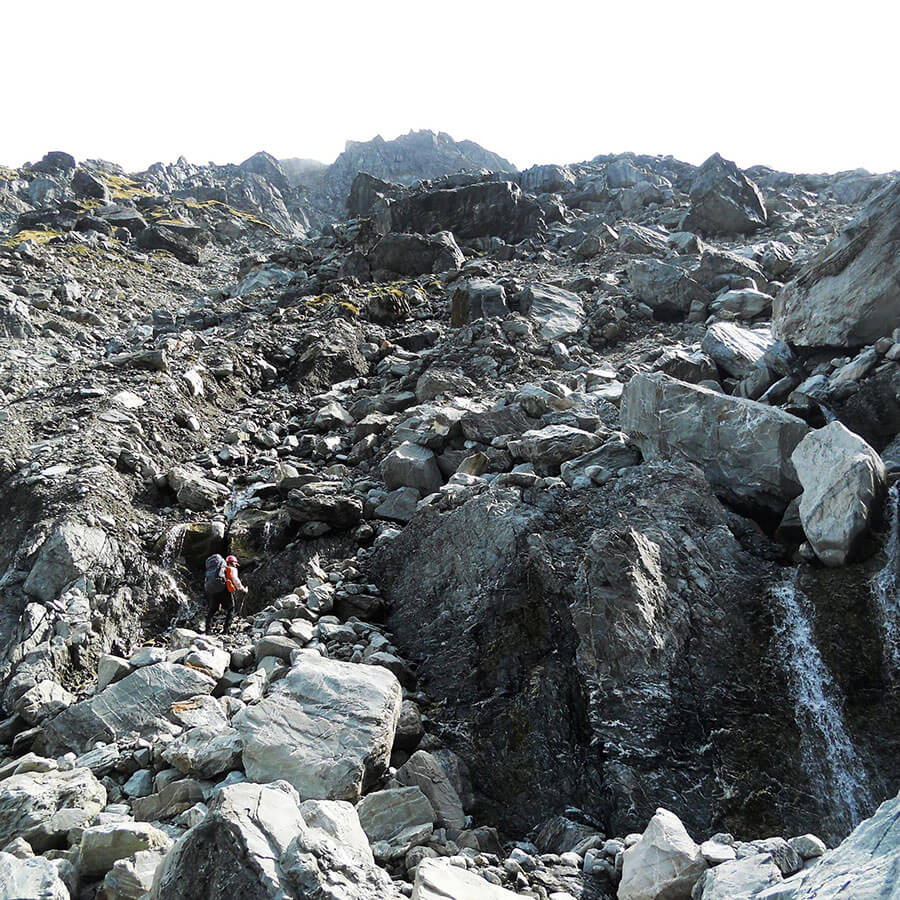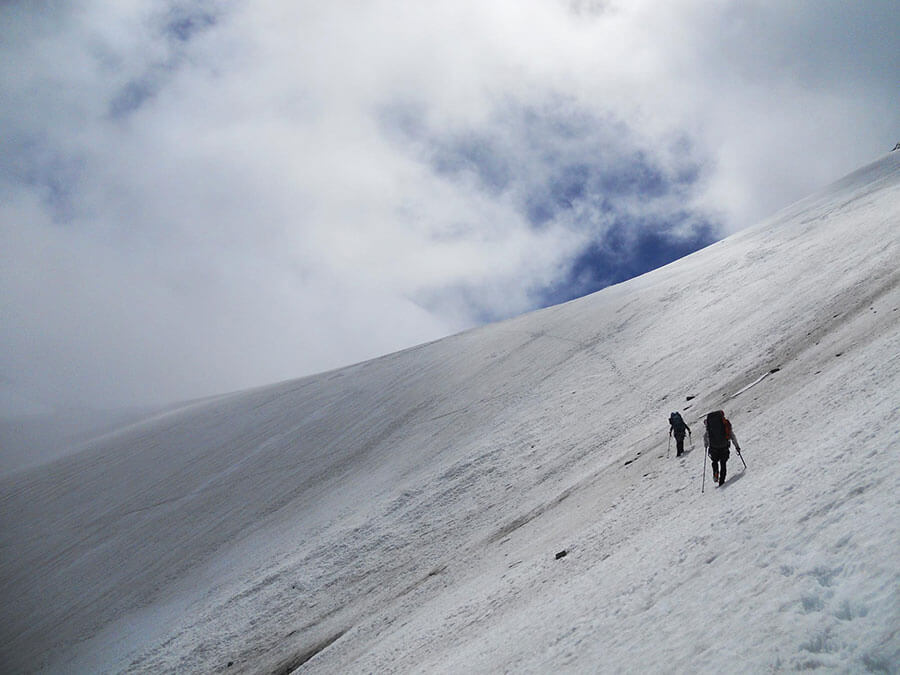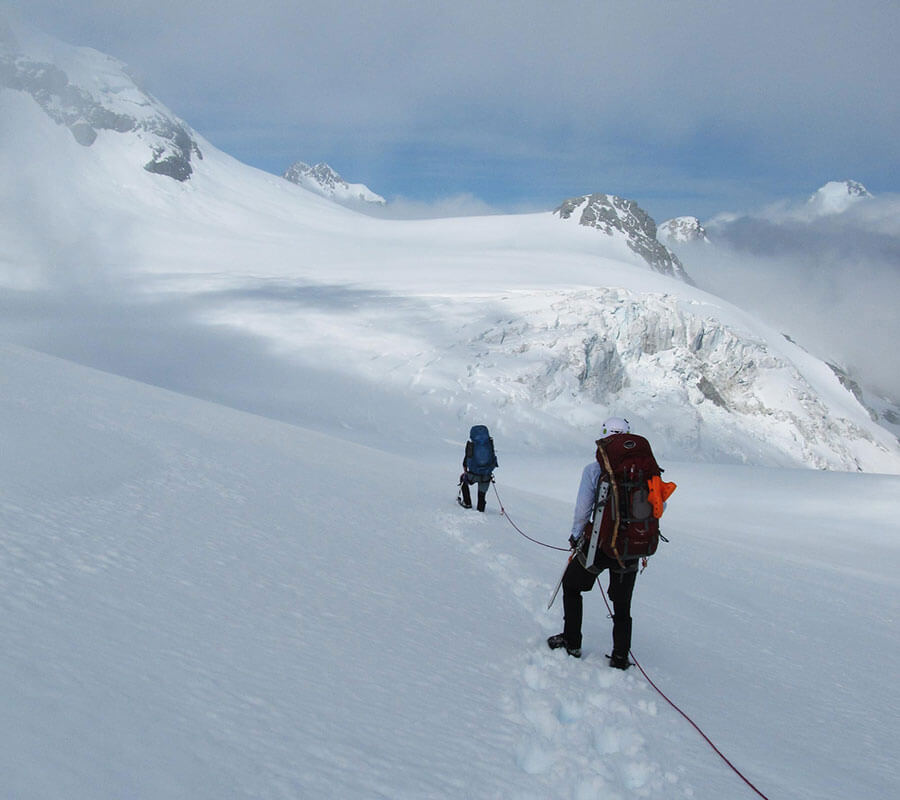If you were to mention to the average New Zealander that there were two huge ice plateaus in the middle of the country three times the size of Rangitoto Island, I think most of them wouldn’t know what you were talking about.
The ice plateaus in the Southern Alps are pretty much an unknown to the general public. Yes, people know about the famous West Coast glaciers, Fox and Franz, but dig a little deeper and that’s where the knowledge usually stops.
The Garden of Eden and the Garden of Allah are incredible geographical wonders what create a pristine, yet fragile, environment that has lasted tens of thousands of years. They are without doubt a special place in my heart and are such a magnificent and unique place to see and protect.

What are ‘the Gardens’?
The Garden of Eden and the Garden of Allah are huge ice plateaus made from tens of thousands of years of accumulated snow and ice that sit on top of a Greywacke plateau at around 1800-2200m above sea level.
The Greywacke rock type is widely known as the “basement rock” of Aotearoa New Zealand and was formed during the Upper Paleozoic to Mesozoic-age (around 300 million years ago). It is a mixture of mudstone and sandstone that is characteristically extremely deformed, fractured, and veined due to the tectonic movements and orogeny since it’s creation. They are therefore more susceptible to cracking and breaking, so create very angular and jagged mountainous vistas.

The Gardens are located between Mt Adams to the west, and the ranges at the head of the Rakaia and Clyde Rivers to the east/south east. They are split down the middle by the John Pascoe Ridge, named after an avid mountaineer in the region back in the 1930’s (more on the naming of the Gardens below).
They are very unique in Aotearoa New Zealand as they run in an east/west direction when most run in a north/south direction. Due to their orientation, the ice plateaus are very exposed to prevailing weather conditions from all directions.
The weather conditions on the Gardens are usually dependent on the pressure differential from the West Coast. The days regularly start off clear in the morning, but by midday have thick cloud across the plateaus (which then lifts in the evening, if you are lucky).
In my experience on the Gardens you need to make sure you have a few days planned to sit in a tent! The weather is either extremely good, or extremely poor, and there is not much in-between!

How do you get to the Gardens?
As the Gardens are part of the Adams Wilderness area, there are no helicopters, charters or vehicles allowed anywhere near the ice plateaus. The only way in or out is via foot, however, the area is well tracked (in a mountaineering sense) with multiple trails into the glacial heads and valleys on all sides.
The most common ways to enter the Gardens are from three directions. From the west at Scone Hut along the Perth River, from the north at Hunters Hut along the Wanganui River, or from the south via Perth Col from McCoy Hut along the Clyde and Frances Rivers.
There are other entry points to the Gardens, but these seem to be the most accessible of the lot. Yvonne Cook and Geoff Spearpoint (Canterbury Mountaineering Club) are the glacial gurus of the Gardens and have literally written the book on the mountaineering routes, trails, climbs and peaks all around Gardens of Eden and Allah over the last 30 or so years.

Why are they named “The Gardens of Eden and Allah”?
The Garden of Eden was the first of the two plateaus to be named back in 1934. According to the 1962 LINZ Gazetter, it was named by Allan Priestley (AP) Thomson, an early mountaineer and an inaugural member of the Mount Cook National Park Board. He was also a life long member of the NZ Alpine Club, and an executive member of the Federated Mountain Clubs (FMC).
The Gazetter writes that the name was initially suggested by J.D. Pascoe but the NZ Geographic Board didn’t accept it based on the name theming in the area. The board wanted a more classic mythological name rather than biblical. However, after the name had been in circulation with mountaineers for many years after 1934, it was finally accepted officially in 1962.
The Garden of Allah was also finally approved in 1971 to match the theme of previous acceptance for the Garden of Eden (and it’s use in the climbing community), although had been disallowed numerous times in the decades preceding.

Next to the ice plateaus, to the west of the Garden of Allah, sits the Beelzebub Glacier. Aptly named due to it’s steeper gradient (and in the continuation to the biblical theme). It was resubmitted by the Director of the New Zealand Geological Survey in 1962 to assist in the compilation of a catalogue of Aotearoa New Zealand’s glaciers.
What is happening with the ice and climate change?
The ice plateaus have only recently (2018 onwards) been measured for the first time by academics from the University of Otago.
Their paper looked at the variability of mass balance on the Gardens of Eden and Allah by testing methodology that could support the mass measurement of glaciers across the Southern Alps using remote sensing and Moderate Resolution Imaging Spectroradiometer (MODIS) satellite data.

Mass balance, in simple terms (according to the USGS) is the measurement of the health of the glacier. Basically it’s the inputs minus the outputs, and a measure of whether they are balanced or not.
Documenting the mass balance changes of the glaciers, can help note the affect of climate change on the mountain ecosystems and will allow scientists and governments to better understand how glacier change will affects ecosystems and resources across the country and globe.
Read more about my trip from Harihari to Whataroa across the Garden of Eden and Allah in 10 days.
